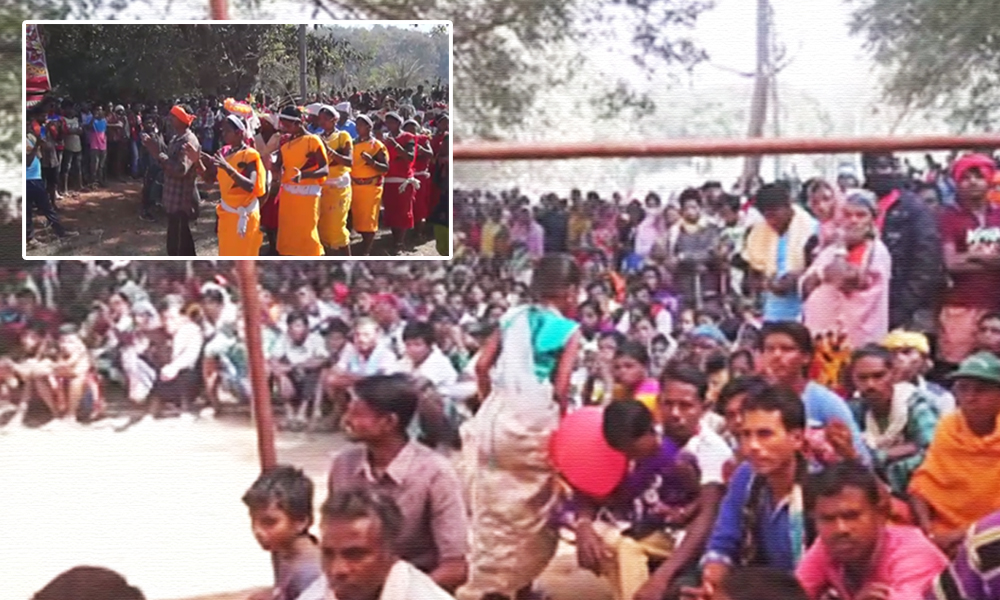
Chhattisgarh: Tribals Protest Against 'Bastar Irrigation project' Once Rejected By Former PM Rajiv Gandhi
Chhattisgarh, 10 Feb 2021 2:16 PM GMT | Updated 11 Feb 2021 6:29 AM GMT
Creatives : Abhishek M
" An engineer by profession, Abhishek is the creative producer of the team, graphic designing is his passion and travelling his get away. In more ways than one, he makes the content visually appealing."
Nearly 6,000 tribals met in Bijapur, Chhattisgarh to protest against the government's move to step-up the 'Bastar Bodhghat project multipurpose irrigation project.'
Chhattisgarh Government's move to reinstitute the Bastar Bodhghat multi-purpose irrigation project in Barsoor village of Dantewada irked local tribals as the project threatens their settlements.
Nearly 6,000 tribals of over 50 villages protested at Chhattisgarh's Hitalkudum village of Bijapur on Tuesday, February 9, to register their protest against the Congress government's move.
Bodhghat project is estimated to cost around Rs 22,000 crore and aimed at generating over 300 megawatts (MW) of hydro-electricity. The multipurpose irrigation project claims of having irrigation potential (post-completion) to cover over 3.66 lakh hectares of land in the southern districts of Chhattisgarh.
According to Hindustan Times, WAPCOS Limited, a private company and Public Sector Undertaking (PSU) of Union Ministry of Jal Shakti has been asked by the Chhattisgarh government to conduct the survey and get approval from the ministries concerned.
"The project was rejected and disposed at the PMO level citing issues of locals, their resettlement, and the loss of Bastar's originality. Now this government wants to build the same dam without even telling what has changed since then and how they plan to make it feasible that hasn't been since the first day" said Arvind Netam, former Union Minister and veteran Congress leader who took part in the protest.
Manish Kunjam of Communist Party of India (CPI) who was also a part of the protest claimed, "They will operate mines, build dams, they wouldn't even ask if we want it or not. The government is trying to bypass all the rules and laws that have been made to safeguard the interests of tribals, we will not let this happen."
However, the State Water Resource Department has given approval to the project in June last year saying that the Bodhghat project would supply water to irrigate over 3.66 lakh hectares of land in the Dantewada, Bijapur, and Sukma districts.
"They have made it a mockery out of tribals' life. No accommodation of public consent, wildlife, rules, and laws. The locals do not want to leave their homes, their jungles, and their perfectly-in-sync life with nature. We will form a committee and raise this with new vigour and make all those in power listen to the last person getting affected by this utopian project" said Soni Sori, a social activist from Bastar.
Despite repeated calls and messages, Ravindra Choubey, Water Resources Minister did not respond to the calls.
Why Rajiv Gandhi dropped Bodhghat irritation project?
The proposal of Bodhghat irritation project first came to light in 1965-66 in the undivided Madhya Pradesh. Then years later in 1979, the then Prime Minister Morarji Desai officially laid the foundation of the project.
Bodhghat project was first in line among other units, Kuturu, Nagur, Bhopalpattnam, and Inchampalli that were to be constructed over the Indravati river as an extension.
Bodhghat project aimed at constructing four hydroelectric production units that would produce 500 MWs of electricity which was to be set-up eight kilometres from Barsoor village in Dantewada district.
Although the project got the environmental clearance in 1979 for the generation of hydropower, it couldn't be taken ahead as the Madhya Pradesh government declined the proposal citing that 'it is not suitable for the tribal-dominated population.'
A study conducted by Madhya Pradesh State Electric Board (MPEB) then also claimed that the irrigation in such a vast area isn't feasible.
The dam was supposed to have a height of 90m with two tunnels of 3 & 5 kilometres. The project would have submerged a total area of 13783.147 hectares (ha) including 5704.332 ha forest land. The government proposed rehabilitation and resettlement of 42 villages with a population of nearly 10 thousand people.
At the time of project initiation in 1979, there was no law concerning forest rights, also no study like Environmental Impact Assessment was in existence that would quantify the impact of any and all projects through environmental aspects.
Till the 1970s, the environmental assessment was done by the Department of Environment (DOE) as a formal duty. However, from 1980, Forest conservation act was passed making it mandatory for all the projects to take the approval for the forest land to be diverted for non-forest use.
Following this, a task group was formed by DOE that visited the project site in 1985. Various groups approached the then PM Rajiv Gandhi asking to stall the project highlighting various social and environmental hazards of the project. Taking this into account, the PM constituted an inquiry committee in 1987 under the chairmanship of secretaries of both Environment and Forest Ministry.
Around the same time, DOE asked the Wildlife Institute of India in 1989 to study the impact of the Bodhghat project which gave a detailed report in 1990. The report concluded that the Indravti river has a unique riparian system, dotted with islands supporting varied parts of ecology and the dam would submerge these islands threatening the wildlife and the ecosystem as a whole.
The report further concluded that Bastar and nearby areas have south moist tropical deciduous forest and have a mixed tree system dominated by trees like Sal, Sagaon, and Bamboo. The area is home to category-1 wildlife including endangered wild animals like forest buffalo, tiger, jackal, and leopard.
A dam of this size and the area that will submerge will pose a life-threatening scenario for these species. Moreover, the downstream of the dam will create a danger for the wildlife preserved in the Bhairamgarh Wildlife Sanctuary.
The report by the Wildlife Institute of India also assessed the impact on the lives of tribals living in the area. The report highlighted that the native tribes Maria, Muria, Jhariya among others have very close bonds with their surroundings.
Forests, trees, wildlife, and themselves form an ecology of the place. The concept of Jal-Jangal-Jameen is what they adhere to and depend mostly on the minor forest produce for their livelihood. The resettlement process and forcing them to switch to agriculture as an occupation wouldn't last.
The government's plan to speed up the project and process in between has been questionable from day one. The new rules like PESA, FRA, Land Acquisition and Rehabilitation act, and others that safeguard the interests of scheduled areas and the people living there pose the question as to 'how and where will this government resettle those getting affected by the project?', ' Will it take over the protected land?' among others.
"Bodhghat project was shelved because it posed severe environmental implications. Now at the time when the entire world is rethinking about their big-dam projects, restarting a project like Bodhghat, which has already been confirmed as a total loss venture is beyond understanding," said Alok Shukla, convener, Chhattisgarh Bachao Aandolan, a pressure group formed in 2009.
He further said, "A proper forum to discuss and find out solutions that do the work without harming the already disturbed environment is the need of the hour."
Also Read: Kerala: Public Service Commission Rank Holders Intensify Protests Over Alleged Backdoor Appointments
 All section
All section













